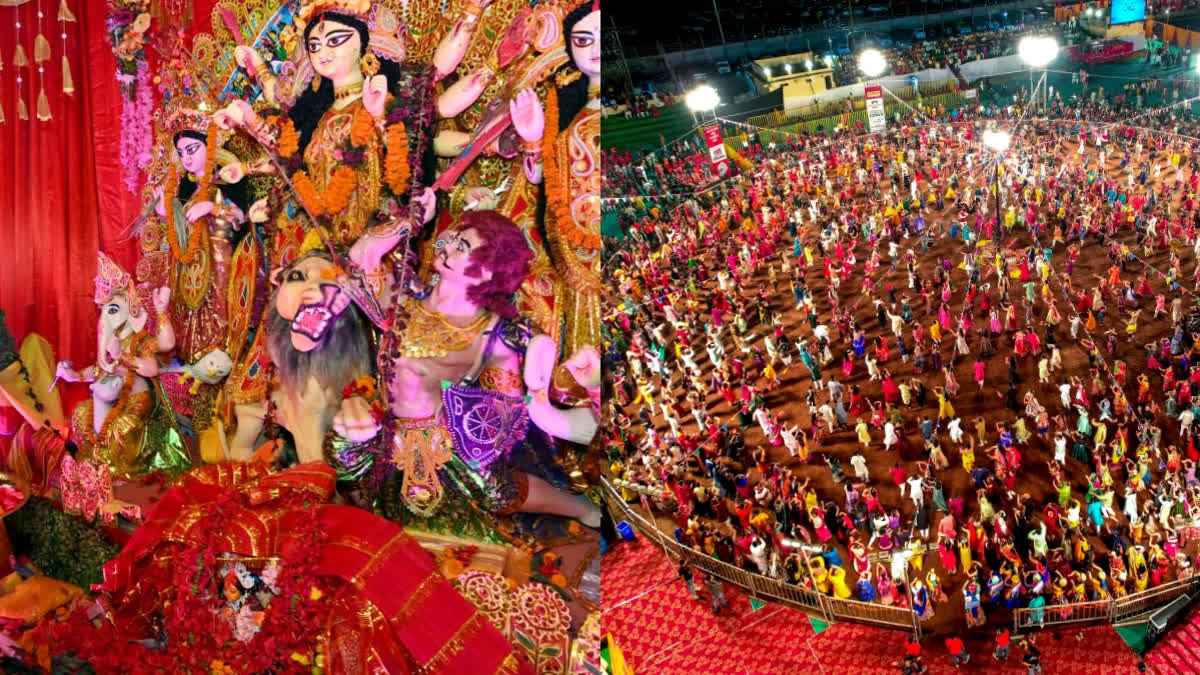Hyderabad: Symbolising the triumph of good over evil, Navratri is a grand festival celebrated across the country for nine days, starting from October 3 to 12. Goddess Durga is worshipped during Navratri to celebrate the day of her victory over Demon Mahisasur. Legend has it that after years of penance, Mahishasura finally caught the attention of Brahma, who offered him a wish. Overcome by ambition, Mahishasura asked for immortality, specifying that he should not be killed by any 'man or animal on Earth. Brahma granted his request but warned him that a woman would ultimately bring about his demise.
This made him oppress many Gods in heaven. Unable to bear his torture, the Gods sought help from Brahma to free them from the tyranny of the demon Mahishasur. In turn, Devi Durga was born and endowed with supreme powers by Lord Brahma to battle against the demon. The fight ensued between Goddess Durga and the demon Mahisasur for 10 days following which on the 10th day Devi managed to win over Mahisasur when she cut the demon's head.
Among the four Navratris celebrated throughout the year--Magha (winter), Chaitra (spring), Ashadha (monsoon) and Shardiya Navratri (autumn)-- are considered the most important, often directed to as Maha Navratri. The Durga Puja is being celebrated to commemorate the fight that went on for 10 days and the last day is known as Vijayadashami. The nine-day festival of Sharad Navratri will end on Saturday, October 12 with Dussehra being celebrated on the same day.
Navratri Celebration Dates 2024
| Navratri Tithis | Date | Puja | Significant Colour |
| Pratipada | 3rd October 2024 | Ghatasthapana | Yellow |
| Diwitya | 4th October 2024 | Maa Brahmacharini Puja | Green |
| Tritiya | 5th October 2024 | Chandraghanta Puja | Grey |
| Chaturthi | 6th October 2024 | Kushmanda Puja | Orange |
| Panchami | 7th October 2024 | Maa Skandamata Puja | White |
| Sashti | 8th October 2024 | Saraswati Avahan, Katyayani Puja | Red |
| Saptami | 9th October 2024 | Kalratri puja | Blue |
| Astami | 10th October 2024 | Maha Gauri Puja, Durga Ashtami | Pink |
| Navmi | 11th October 2024 | Maa Shiddhidatri Puja, Maha Navmi | Purple |
| Dasmi | 12th October 2024 | Vijay Dashmi (Dusshera) | Vibrant colours |
Rituals during Navratri
Devotees during Navratri observe fast, abstaining from onions, garlic, meat and alcohol. In Eastern India, especially in West Bengal, Navratri is celebrated as Durga Puja, the most significant festival of the year. Large pandals are set up and illuminated with lights and diyas, with various other religious activities taking place. It is that time of the year when people gather across different states of the country dressed up in traditional attire with sticks in their hands to enjoy the Navratri dance known as Dandiya or Garba.
Kanya Pujan also known as Kanjak is performed during Navratri to honour young girls as manifestations of Goddess Durga. It is believed that performing this sacred ritual will help one gain the blessings of the Goddess Durga and acknowledge the power bestowed on the girl child, making this ceremony an important aspect of the Navratri celebrations.
Distinct forms of Maa Durga during the nine nights of Navratri:
Shakti: She is worshipped as 'Shakti,' the deity of power at the beginning of three days.
Lakshmi: For the next three days, She is revered as Lakshmi, the God of Wealth.
Saraswati: In the final three days of the Navratri festival, she is honoured as Saraswati, the deity of knowledge and wisdom.
Do's and Dont's
Many devotees observe fast to devote themselves and seek the blessings of Devi Durga as well as to sanctify their souls. However, when fasting during Navratri there are a lot of constraints that need to keep in mind.
Opt for Sattvic Diet
Sattvick is a Sanskrit word that refers to pure. Avoid non-vegetarian food, alcohol, meat, onion and garlic during this sacred nine-day festival. You can eat vrat-friendly food items like 'falhari', sabudana and ragi. Try to avoid eating processed fast foods, semolina and packaged food items. Also, while cooking ditch regular iodised salt and switch to 'sendha namak' (rock salt).
Avoid Arguments or Violence
Arguments, quarrels and violence must be avoided during Navratri as it is believed that during this time, God and Goddess visit our homes to bless us with knowledge, happiness, good fortune and health.
Don't Shave, or Cut Hair and Nails
It is believed that shaving or cutting hair, and nails brings misfortune and deviates one's mind from the purpose of the Navratri Puja as it is done to maintain the beauty standards. It is an auspicious time of the year, so try to have your hair cut before the festival.
Don't leave the home empty
Many people perform the Navratri Puja by lighting the Akhand Deep. Someone must stay at home if the Akhand Jyoti has been lit. Akhand Jyoti is lit to express devotion towards Maa Durga and for consistent lighting of the Jyoti. Leaving the Jyoti alone with nobody in the house is considered disrespectful to the Goddess.
Do follow the Sattvic Lifestyle
Avoid being involved in gossiping and criticising anybody. Perform aarti two times a day in the morning and evening. Help the people in need even if it's a little help.
Read More



